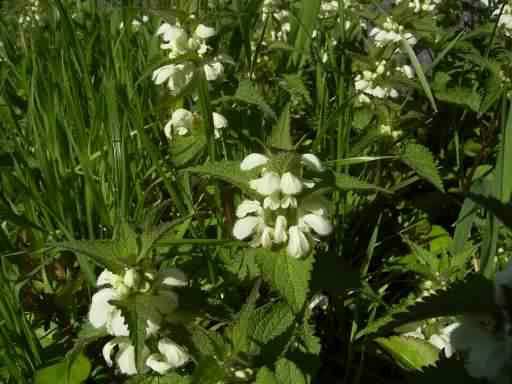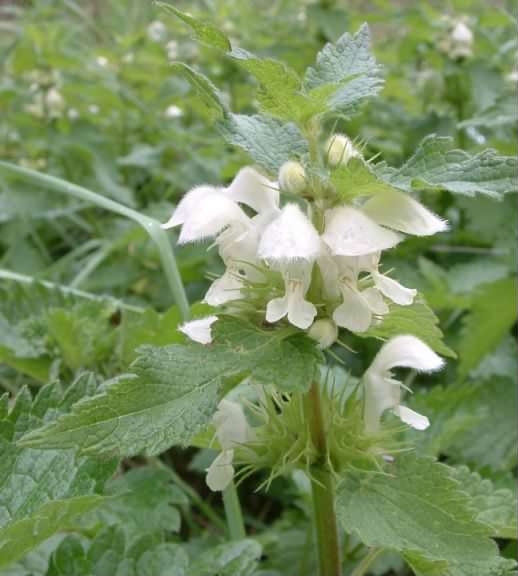
Photo ©2004 TeunSpaans
Click any photo for a larger image

Photo ©2004–

Photo ©2004 TeunSpaans
Click any photo for a larger image

Photo ©2004–
White Dead–nettle - Lamium album
Family - Lamiaceae
Also known as - White Nettle or Bee Nettle
An herbaceous rhizomatous perennial of grass verges and disturbed ground growing to 40–75cm (16–29in tall). Hairy stems with elongated heart shaped softly hairy nettle like leaves 3–8cm (1.2–3.1in) long and 2–5cm (0.8–2.0in) broad, triangular with a rounded base, softly hairy, with a serrulate margin and a petiole up to 5cm (2.0in) long. Like many other members of the Lamiaceae family, they appear superficially similar to Common Nettle but they do not sting, hence the common name "Dead–nettle". White orchid like hooded flowers 20–25mm (0.8–1in) long, in whorls found March to December, the upper hood is hairy. It is a food plant for many insects especially Bumblebees which are attracted to the flowers as a good source of early nectar and pollen, hence the plant is sometimes called the Bee Nettle.
The hermaphroditic flowers are pollinated by Bees, ripening July to December to a small brown achene. It is noted species for attracting wildlife. Native throughout Europe and Western Asia, growing in a variety of habitats from open grassland to woodland, generally on moist, fertile soils. Common in the UK. except in the North. It is an introduced species to North America, where it is widely naturalised and also into Iceland and New Zealand. There are several variegated forms which are grown as ornamental herbaceous perennials.
Suitable for light (sandy), medium (loamy) and heavy (clay) soils preferring a well–drained location. Suitable pH: acid, neutral and basic (alkaline) soils. It can grow in semi–shade (light woodland) or no shade. It prefers moist soil. A very easily grown plant, there are several commercial varieties for the garden. It tolerates most soils and conditions and grows well in heavy clay soils, preferring a sunny position, though it also does well in partial shade. White Dead–nettle tends to be weedy when grown in the flower garden, but it does well in the wild garden and self–sows when well sited. It usually self sows easily. If dividing do so in the spring but division will usually succeed at almost any time in the growing season. Larger clumps can be replanted direct into their permanent positions, though it is best to pot up smaller clumps and grow them on in a cold frame until they are rooting well. The plant has a creeping rootstock and makes a good ground cover plant for woodland edges.
BCP do not advise or recommend that White Dead–nettle – Lamium album is eaten or used as an herbal remedy. The young leaves are edible and can be eaten raw, used in salads or cooked as a vegetable. The plant is also used in herbal medicine as a dermatological remedy, the flowers boiled in water can be used as a traditional catarrh remedy, and the roots boiled in wine as a remedy for kidney stones. A distillation of the flowers is reputed to "make the heart merry, to make a good colour in the face, and to make the vital spirits more fresh and lively".
Also see - Red Dead–nettle and Stinging Nettle.
Site design ©1999– Brickfields Country Park - Privacy -